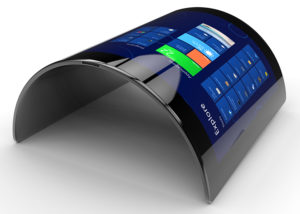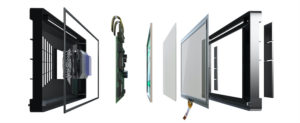 Dow (NYSE: Dow) will showcase two advanced products and four new technologies for next-generation consumer electronics and automotive displays at the virtual Display Week 2020 show, Aug.3-7, 2020. The products include new generation DOWSIL VE-6001UV-T Optical Bonding material for high-reliability displays in harsh environments, and DOWSIL VE-8001 Flexible Silicone Adhesive for flexible and foldable displays. The new technologies that Dow plans to spotlight are silicone(Si)-organic hybrid adhesives that improve the mechanical strength of silicones and the durability of organic materials; a low-k (dielectric constant) silicone that stores less energy and offers excellent thermal stability; optical silicone hotmelt films (SHF) for the warp-free encapsulation of large substrates made of thin and flexible printed circuit boards (PCBs) or films; and a fast ultraviolet (UV) curing adhesive, DOWSIL VE-6520 UV Optical Adhesive.
Dow (NYSE: Dow) will showcase two advanced products and four new technologies for next-generation consumer electronics and automotive displays at the virtual Display Week 2020 show, Aug.3-7, 2020. The products include new generation DOWSIL VE-6001UV-T Optical Bonding material for high-reliability displays in harsh environments, and DOWSIL VE-8001 Flexible Silicone Adhesive for flexible and foldable displays. The new technologies that Dow plans to spotlight are silicone(Si)-organic hybrid adhesives that improve the mechanical strength of silicones and the durability of organic materials; a low-k (dielectric constant) silicone that stores less energy and offers excellent thermal stability; optical silicone hotmelt films (SHF) for the warp-free encapsulation of large substrates made of thin and flexible printed circuit boards (PCBs) or films; and a fast ultraviolet (UV) curing adhesive, DOWSIL VE-6520 UV Optical Adhesive.
“Dow has one of the broadest and most robust portfolios of optical silicones and silicone-based solutions for displays on the market today,” said Jayden Cho, global marketing segment leader for Consumer Electronics at Dow. “From innovative optical bonding materials to novel silicone-organic adhesives, Dow has been listening to what the industry needs in terms of assembly, reliability and performance. Moreover, as we continue to innovate, Dow is closely monitoring technology trends to further ensure that we are delivering the right solutions for our customers.”
Today’s display manufacturers need optical materials that support high-volume production but are inexpensive and visually pleasing. Optically clear bonding materials and adhesives must dispense readily, cure quickly and provide long-lasting attachment without cracking or becoming yellowish or hazy. These materials also need to withstand demanding environments. For example, automot

Exploded view automotive display
ive interior displays must endure high temperatures, elevated humidity and prolonged exposure to sunlight, and the displays for consumer electronics need excellent impact resistance and better out coupling, along with lower power consumption. Optical silicone bonding materials and adhesives are well suited for both environments and can withstand the higher temperatures associated with micro/mini light-emitting diode (LED) chips in new emerging displays. Display manufacturers also need optical silicone technologies with greater mechanical strength and ease of application.
Among Dow’s broad range of silicone-based technologies, the company’s two advanced materials at Display Week 2020 include:
- DOWSIL VE-6001 UV-T Optical Bonding material is engineered to perform under demanding conditions within automotive interiors while offering enhanced display reliability. This one-part material offers notably greater thermal stability than organic materials and exhibits less than 1% shrinkage, making it suitable for larger panel displays. After curing, this high-performance bonding material is extremely soft for a combination of stress relief and dimensional stability that helps to protect electronics from impact.
- DOWSIL VE-8001 Flexible Silicone Adhesive is designed for flexible and foldable displays for smartphones, wearables, televisions and large format displays. This two-part primerless silicone adhesive is applied directly to thin metal surfaces and forms an elastic layer, or inner hinge, that helps to protect the display from damage caused by folding and unfolding. Dow’s four new silicone-based technologies to be highlighted at Display Week 2020 include:
- Si-organic hybrid adhesives are compounds that increase the mechanical strength of silicone and the durability and environmental stability of organic materials. These new hybrid materials are easy to process and offer strong adhesion to a variety of substrates, including aluminum, glass, plastic and epoxy.
- •Low-k (dielectric constant) silicone combines high optical clarity with reliability under harsh conditions. With their low k value of 2.3 to 2.6, these silicone-based dielectric materials (silsesquioxanes) provide good thermal stability, reliable mechanical properties (flexible to rigid) and can be tailored based on multiple technical needs to support conventional liquid processes (inkjet printing), as well as compatibility with various substrate materials (metal, glass and plastics).
- Optical SHF materials encapsulate large surfaces and are suitable for applications where liquid curable silicones may be difficult to use. These heat-cured films are molded or laminated with substrates and relieve thermal stresses for warp-free molded/laminated results. They have a high optical transparency to support clearer, brighter displays in consumer electronics and offer excellent warp-free performance in microelectronics. •DOWSIL VE-6520 UV Optical Adhesive is a fast-curing adhesive for assembling liquid crystal displays (LCDs) and organic light-emitting diodes (OLEDs) in consumer and automotive products. This new material is also used in smartphones with under-display cameras and optical fingerprint recognition. Because this adhesive initiates curing during the gel bonding stage (B-stage), low UV power is required. Bonding after UV exposure also reaches shadowed areas where UV light may not penetrate.
For more information, visit dow.com or follow @DowNewsroom on Twitter.




Tell Us What You Think!